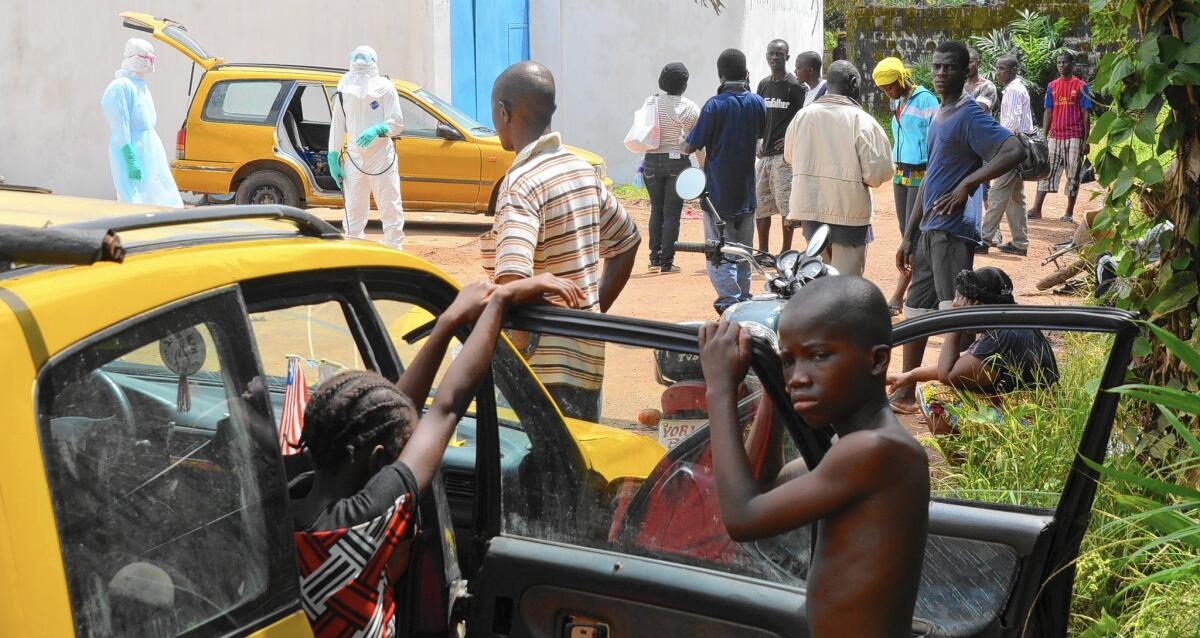Ebola epidemic more deadly than all previous combined, report says

- Share via
The Ebola epidemic has already killed more people than all previous outbreaks combined, and an alarming new analysis by the World Health Organization suggests it already may be too late to prevent the virus from taking up permanent residence among humans in West Africa.
The virus itself is no more lethal or virulent than its predecessors, according to a report published Tuesday by the New England Journal of Medicine. But conditions in the affected regions of Africa — including a lack of approved drugs or vaccines, frequent cross-border travel and the failure to implement timely infection control measures — have made the epidemic unlike any before it.
Based on data collected during the last nine months, a panel of more than 60 WHO experts estimated that more than 20,000 people would be infected with Ebola by Nov. 2. The researchers also found that the disease had been fatal in 71% of confirmed cases.
“The current epidemiologic outlook is bleak,” the experts wrote. “We must therefore face the possibility that Ebola virus disease will become endemic among the human population of West Africa, a prospect that has never previously been contemplated.”
The suggestion that Ebola might never leave humans took some researchers by surprise.
“Diseases with a very high mortality, like Ebola, don’t usually persist because they are too effective at killing their hosts,” said Sherry Towers, a mathematical and computational modeling professor at Arizona State University. “A dead person can’t move around in the population and continue to spread disease to susceptible hosts.”
If a virus is slow to mutate — as Ebola appears to be — the pathogen gradually disappears from humans, for a couple of reasons. First, the percentage of the population that gets infected and develops immunity increases over time. Second, people modify their behavior and limit contact with one another. As a result, the virus finds it more difficult to spread and eventually runs out of human hosts.
At the end of past Ebola outbreaks, experts believe the virus retreated to its suspected animal reservoir, fruit bats. It may have lingered there for years until an infected bat came into contact with a human.
However, if the virus remains alive in at least some people, it remains an ongoing threat to public health.
In their first full statistical analysis of the epidemic, the WHO panel concluded that the exponential spread of the Zaire species of Ebola — named for the African nation now known as the Democratic Republic of Congo — was due more to geography, population density and an “insufficient” public health response than to any “biologic characteristic” of the virus.
The WHO researchers concluded that the three hardest-hit nations — Guinea, Liberia and Sierra Leone — were suffering because of the mobility of their populations and a lack of rapid and rigorous infection-control measures.
The region is highly interconnected, with frequent cross-border traffic among rural towns, villages and dense urban areas. As a result, “the large intermixing population has facilitated the spread of infection,” the authors wrote.
The virus first gained a foothold in December 2013 and was not officially recognized as an outbreak until March 23.
Although the United Nations health organization estimated just days ago that at least 5,843 people had been infected and at least 2,803 killed so far, the true numbers are “certainly higher,” the WHO panel added. However, the researchers noted that the mortality rate dropped from 71% to 64% for patients who were cared for in a hospital.
The ability of medical teams to collect accurate case numbers has been complicated by fear and desperation in the face of the virus, which is transmitted through bodily fluids. Some infected people have been hidden by their families because they fear the ostracism that comes with being diagnosed with Ebola. In some communities, medical teams have been greeted with violence.
In order to stop the epidemic, researchers said the rate of transmission would have to be cut in half. This would be equivalent to vaccinating 50% of the population, according to study authors. Several vaccines are now under development, but even if they are shown to be effective, they won’t be available in large quantities for several months, officials say.
Another study, released Tuesday by the U.S. Centers for Disease Control and Prevention, said that if 70% of patients were properly isolated in a hospital, home or community setting, and safe burial practices were instituted, the epidemic “would almost be ended” by Jan. 20.
The CDC study also contained a worst-case scenario, in which no action were taken to stem the spread of the disease in Sierra Leone and Liberia. (Guinea was removed from the forecast because its data were too erratic for reliable statistical use.) In this hypothetical situation, CDC analysts estimated there could be anywhere between 550,000 and 1.4 million new cases in those two nations by the end of January.
“We don’t think that will come to pass,” CDC Director Dr. Tom Frieden said of the worst-case estimate. “These are not projections. What we’ve done is outline what might happen in different scenarios.”
Frieden said the scenarios, published in the agency’s Morbidity and Mortality Weekly Report, were intended to demonstrate the urgent need for a rapid scaling-up of international medical aid.
“The model shows that a surge now can break the back of the epidemic,” he said. “It also shows that there are severe costs of delay.”
Twitter: @montemorin







